Bitez Beach, near Bodrum, Turkey, Thursday morning, 14 June 2001
Tuesday I went into Bodrum for ATM and other errands while Stas and the children had a day at the beach. When I had finished the errands and was walking back to where I had parked the car, a barber accosted me from the front step of his shop and suggested that I needed his services. I declined and walked on but then changed my mind and turned around. I was agreebly surprised to find that the low price included an expert massage of face, hands, and arms.
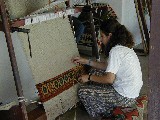

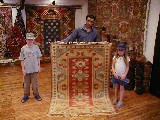 Yesterday we drove north to see some archaeological sites. We began with Ephesus, the furthest north of those we had in mind, and the biggest. At the parking lot near the bottom end of the site we were hustled into a free (?) shuttle car that would take us to the top, on the understanding that we look in at a rug-making school cum emporium on our way out of the site. Indeed, as a massive cruise ship had just discharged its coaches there at the top, we were readily persuaded to visit the rug place first, to kill some time until the great wave of tourist humanity should have passed on down. Sure enough, we wound up buying a rug, made in the Troad, of wool dyed with saffron and tobacco. The photo at right will help us make sure that what arrives at our home in the USA is indeed the one we selected and bargained for.
Yesterday we drove north to see some archaeological sites. We began with Ephesus, the furthest north of those we had in mind, and the biggest. At the parking lot near the bottom end of the site we were hustled into a free (?) shuttle car that would take us to the top, on the understanding that we look in at a rug-making school cum emporium on our way out of the site. Indeed, as a massive cruise ship had just discharged its coaches there at the top, we were readily persuaded to visit the rug place first, to kill some time until the great wave of tourist humanity should have passed on down. Sure enough, we wound up buying a rug, made in the Troad, of wool dyed with saffron and tobacco. The photo at right will help us make sure that what arrives at our home in the USA is indeed the one we selected and bargained for.

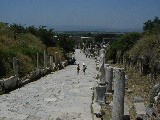
 We opted for a professionally guided tour through the site. This was entertaining and informative enough, though I knew some of the things our guide told us to be wrong. (He thought the theater's orchestra was a place for musicians, for instance; rather, it was the dancing floor for the chorus of Greek dramas.) At right is one of many Ionic capitals on the site modified with the addition of a bull's head. (I cannot say I much admire the innovation.) Virtually all here is Roman in period and style.
We opted for a professionally guided tour through the site. This was entertaining and informative enough, though I knew some of the things our guide told us to be wrong. (He thought the theater's orchestra was a place for musicians, for instance; rather, it was the dancing floor for the chorus of Greek dramas.) At right is one of many Ionic capitals on the site modified with the addition of a bull's head. (I cannot say I much admire the innovation.) Virtually all here is Roman in period and style.

 The gate-post at left shows Heracles, or perhaps here one should rather call him Hercules, as a beardless young man, which is unusual. At right, a temple to the emperor and ipso facto divinity Hadrian features many fine reliefs including portraits of Tuchê (Fortune) on the keystone of the nearer arch and Medusa on the tympanum behind.
The gate-post at left shows Heracles, or perhaps here one should rather call him Hercules, as a beardless young man, which is unusual. At right, a temple to the emperor and ipso facto divinity Hadrian features many fine reliefs including portraits of Tuchê (Fortune) on the keystone of the nearer arch and Medusa on the tympanum behind.
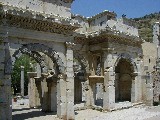
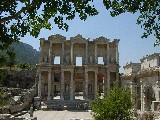
 At left, two buildings from the corner where the "Street of the Curetes" meets the "Marble Road." The gate is inscribed with the names of Caesar Augustus and Caesar's wife Livia above those of the slave-born architects, a courtesy that won them emancipation. The two-storey façade belongs to the Library of Celsus--not the physician, but the father of a Roman consul who built this for him as a memorial library cum tomb. At right, the great theater where Paul is said to have preached the Christian gospel and some makers and vendors of silver idols are said to have raised a claque and a clamor against him. Our guide seemed much more up on this popular subject than on the city's great native son, the philosopher Heraclitus, whom he never so much as mentioned. It was Heraclitus who said that you cannot step into the same river twice, a sentiment quoted oddly enough in the Disney animated feature Pocahontas. (The notoriously wayward local river Meander, which silted up the harbors of both Ephesus and Miletus, may well have given him this idea, as well as giving us its name as a verb.)
At left, two buildings from the corner where the "Street of the Curetes" meets the "Marble Road." The gate is inscribed with the names of Caesar Augustus and Caesar's wife Livia above those of the slave-born architects, a courtesy that won them emancipation. The two-storey façade belongs to the Library of Celsus--not the physician, but the father of a Roman consul who built this for him as a memorial library cum tomb. At right, the great theater where Paul is said to have preached the Christian gospel and some makers and vendors of silver idols are said to have raised a claque and a clamor against him. Our guide seemed much more up on this popular subject than on the city's great native son, the philosopher Heraclitus, whom he never so much as mentioned. It was Heraclitus who said that you cannot step into the same river twice, a sentiment quoted oddly enough in the Disney animated feature Pocahontas. (The notoriously wayward local river Meander, which silted up the harbors of both Ephesus and Miletus, may well have given him this idea, as well as giving us its name as a verb.)
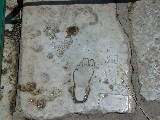
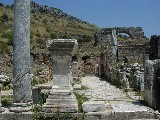 Our guide interpreted the incised markings on this marble paving stone (left, from the "Marble Road") as an advertisement directing custom to the brothel (right). The left footprint means ahead and on the left, while the cross just in front of it means at the crossroads; the heart and the figure of a woman rather speak for themselves in this interpretation. I could not make out the figure of a bird that he said advertised music, as in "wine, women, and song."
Our guide interpreted the incised markings on this marble paving stone (left, from the "Marble Road") as an advertisement directing custom to the brothel (right). The left footprint means ahead and on the left, while the cross just in front of it means at the crossroads; the heart and the figure of a woman rather speak for themselves in this interpretation. I could not make out the figure of a bird that he said advertised music, as in "wine, women, and song."
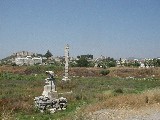
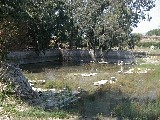
 Just one re-erected column stands out of the forest of one hundred twenty-nine that made up the peristyle of the huge temple of Artemis, one of the seven wonders of the ancient world. Storks nest atop it; doubtless the goddess would approve. (In the background you can see the Isa Bey mosque and yet another castle built by the knights of St. John of Jerusalem.) The west or rather northwest end of the temple is a wetland and also supports avian life. One bird I found there, however, seemed more appropriate to a Heraion than to an Artemision.
Just one re-erected column stands out of the forest of one hundred twenty-nine that made up the peristyle of the huge temple of Artemis, one of the seven wonders of the ancient world. Storks nest atop it; doubtless the goddess would approve. (In the background you can see the Isa Bey mosque and yet another castle built by the knights of St. John of Jerusalem.) The west or rather northwest end of the temple is a wetland and also supports avian life. One bird I found there, however, seemed more appropriate to a Heraion than to an Artemision.

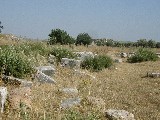
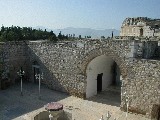 On our way back here from Ephesus we stopped at Miletus. The car's outside-temperature thermometer registered forty-four Celsius (one hundred eleven Fahrenheit), and only Larissa and I ventured out of the air-conditioned car to look round. The Roman theatre looming up out of the flat alluvial plain is impressive, but little or nothing remains of the much earlier city that gave birth to Thales, the first philosopher and the first scientist, and some of his early successors including Anaximander and Anaximenes. As the first to speculate about the makeup of the universe and to try to explain it without reference to supernatural agencies, Thales may justly be considered the father of the Greek intellectual miracle, and this its mother-city. The city's fall to the Persians in 495 B.C. was one of the prime motivations for Athens to move against Persia and thus provoke the Persian invasions into mainland Greece, for the Athenians appreciated Greek culture's massive debt to this place. Even the site of the earlier city is uncertain; it was near here but not precisely here, as the Milesians are recorded to have rebuilt on a new site after the Persians destroyed their city. After looking round a bit we were invited into the 700-year-old caravanserai seen at right. Our host, the new owner, was turning it into another rug school and emporium, and tried to get us to be his first customers, but we had been there and done that in the morning. The vaulted gallery surrounding the courtyard was astonishingly cool inside. Returning to the car we were accosted by two Turkish soldiers, who bade us sit at their table and invited to us to share tea. Noting their Uzis I duly sat, but made my excuses and got out of there as soon as possible.
On our way back here from Ephesus we stopped at Miletus. The car's outside-temperature thermometer registered forty-four Celsius (one hundred eleven Fahrenheit), and only Larissa and I ventured out of the air-conditioned car to look round. The Roman theatre looming up out of the flat alluvial plain is impressive, but little or nothing remains of the much earlier city that gave birth to Thales, the first philosopher and the first scientist, and some of his early successors including Anaximander and Anaximenes. As the first to speculate about the makeup of the universe and to try to explain it without reference to supernatural agencies, Thales may justly be considered the father of the Greek intellectual miracle, and this its mother-city. The city's fall to the Persians in 495 B.C. was one of the prime motivations for Athens to move against Persia and thus provoke the Persian invasions into mainland Greece, for the Athenians appreciated Greek culture's massive debt to this place. Even the site of the earlier city is uncertain; it was near here but not precisely here, as the Milesians are recorded to have rebuilt on a new site after the Persians destroyed their city. After looking round a bit we were invited into the 700-year-old caravanserai seen at right. Our host, the new owner, was turning it into another rug school and emporium, and tried to get us to be his first customers, but we had been there and done that in the morning. The vaulted gallery surrounding the courtyard was astonishingly cool inside. Returning to the car we were accosted by two Turkish soldiers, who bade us sit at their table and invited to us to share tea. Noting their Uzis I duly sat, but made my excuses and got out of there as soon as possible.
previous entry
next entry
main/ToC page


 Yesterday we drove north to see some archaeological sites. We began with Ephesus, the furthest north of those we had in mind, and the biggest. At the parking lot near the bottom end of the site we were hustled into a free (?) shuttle car that would take us to the top, on the understanding that we look in at a rug-making school cum emporium on our way out of the site. Indeed, as a massive cruise ship had just discharged its coaches there at the top, we were readily persuaded to visit the rug place first, to kill some time until the great wave of tourist humanity should have passed on down. Sure enough, we wound up buying a rug, made in the Troad, of wool dyed with saffron and tobacco. The photo at right will help us make sure that what arrives at our home in the USA is indeed the one we selected and bargained for.
Yesterday we drove north to see some archaeological sites. We began with Ephesus, the furthest north of those we had in mind, and the biggest. At the parking lot near the bottom end of the site we were hustled into a free (?) shuttle car that would take us to the top, on the understanding that we look in at a rug-making school cum emporium on our way out of the site. Indeed, as a massive cruise ship had just discharged its coaches there at the top, we were readily persuaded to visit the rug place first, to kill some time until the great wave of tourist humanity should have passed on down. Sure enough, we wound up buying a rug, made in the Troad, of wool dyed with saffron and tobacco. The photo at right will help us make sure that what arrives at our home in the USA is indeed the one we selected and bargained for.















